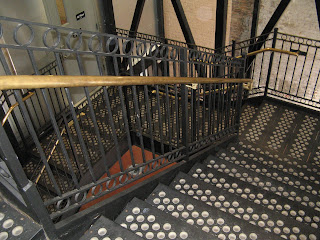The Thomas Edison National Park houses his industrial complex, laboratory and his personal estate, which he sold to his wife to avoid creditors, when he lost millions on the phonograph. This collection is one of largest in the US Park system. Because the whole complex was closed shortly after he died in 1931, everything stands just as it did then. Their personal estate was given over by his wife Mina, at her death in 1947, complete with furnishings and personal photos. Both Edisons are buried on the estate grounds.
To understand this complex, driven man isn't easy because brilliance is sometimes as much a curse as a gift. His first wife died, but his second marriage to beautiful, rich, socialite, Mina Miller, was troubled, understandably, since Edison spent more time with his inventions than his family. He had this small bed in his office to be close to tools, drawings and his library in case of inspiration during the night. He often worked long hours into the night and napped frequently.
Edison is best remembered for his invention of the light bulb and phonograph, but he held 1093 patents. Electricity, and all the resulting products to come, were on the horizon of unknown territory. He researched and extended everything he did to make sure that his inventions would be usable and marketable. His first invention was for a legislative vote recorder. He was a millionaire by age 26. Astounding, when one considers that Edison was completely deaf in one ear and 80% deaf in the other ear. Maybe that is why he was so fascinated by sound machines, the phonograph, the dictaphone (picture above), a movie making enterprise, amplifying musical instruments, and so many other bits and parts of what we take for granted today.
Historians consider that perhaps his greatest invention was the industrial complex. He produced everything to make his inventions usable and marketable in his own production companies. He hired brilliant people, some of whom went on to great inventions and patents of their own. He hired women, Jews, Blacks. It didn't matter to him who you were as long as you had talent to contribute, unlike his friend and peer, Henry Ford, who was openly racist and anti-Semitic. It was easy to respect this man who was not into self aggrandizement. He openly philosophized that people needed to try hard, work hard and never give up.
His wood shops, machine shops and industrial tools, molds and study center shows a fascinating picture of the way things worked. No safety measures, for instance. If a man lost a finger, or was chemically burned, he was no longer employable. There were no benefits or disability payments. Even so, in 1896 when a German Physicist invented the X-ray, Edison quickly set out to replicate his invention and then see what he could do to improve it and figure what other uses this invention could be applied to. His employee got sick in the process and Edison abandoned work on X-ray when he realized the illness was a result of work on that project. He labeled it dangerous and backed off.
Typically, Edison would mentally configure a new invention, draw it and bring it to the shop and have the craftsmen build it, all the while fine tuning it as they went. He could sometimes work on 20 projects simultaneously that way. And, an employee might spark a new idea while working on the project.
This glob of material in his chemical building was a form of rubber he was working on at the time of his death at age 84. He had already produced a proto-type set of tires with rubber made from the goldenrod plant. He hoped to find a local source for rubber rather than import it from Asian. This museum has much to see. Working belt driven machines of all kinds. Extensive lab equipment, state of the art for its day. Many prototypes; five or more phonographs as he continually built, refined and produced cylinders to make his product usable. He was bested by the Victor Company who came out with a disk, and produced a cheaper machine. He felt quality was more important and lost millions on his superior product. I was fascinated by the lighted stairs in his complex.
Holes filled with a translucent material allows light from below to shine through as you walk. The whole complex is filled with innovative products and devices. Heaven for a mechanical junkie.
I enjoyed the tour through his personal estate, as well. He was wealthy and converted this gas lit building to
bare-bulbed, electrically lit, chandeliers.
The chandeliers were different in every room. He could and did design fixtures with the bulbs inside the globe but liked to have them outside the globe as well.
Edison had six children, three by each wife. Mina Miller Edison raised them all. I liked this tender picture of him with his infant son. If you go, the museum is located in West Orange, NJ. The staff has demonstrations of his phonograph, movies he made, and plenty of insight into his life from the estimated 5 million documents, notes, letters, 10,000 artifacts. He was a giant of American innovation and industry.











No comments:
Post a Comment